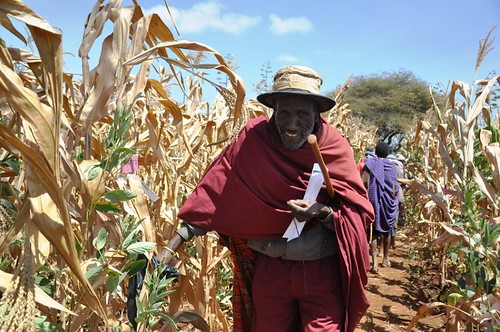Project boosting productivity of farmers’ traditional mixed farming systems in Tanzania
“I like variety 5. The cob has many rows and the grains have filled the cob well. There are also two cobs on the maize stalk,” Esther Liberati, 43-year-old farmer from Seloto village in Babati district in Tanzania, explains her number one choice from a set of 10 different types of maize being tested for adaptability to the region. This is after she painstakingly accessed each of them, feeling the weight of the cob and even counting all the grain rows to make her selection.
Esther was among the over 100 farmers who took part in a series of Farmers Field days organized by Africa RISING in her village, which is one of the project’s action sites. The field days had three objectives; the first was to demonstrate to the farmers improved farming methods including proper spacing when intercropping maize and pigeon pea and the use of organic fertilizer.
The second was to involve farmers in the selection of improved high-yielding and drought-tolerant varieties that are suitable to the region but which also meet their preferences; and lastly, to collect baseline information on farmers in the area as part of the project’s monitoring and evaluation activities.
The field days were held in Seloto and Dulang villages in Babati district, Manyara Region, Northern Tanzania.
Organizations involved in the field day included IITA, the International Maize and Wheat Improvement Centre (CIMMYT), Selian Agricultural Research Institute (SARI), and IFPRI.

Selecting the top four
According to Jumbo McDonald, a maize breeder with CIMMYT, they wanted to select the four best performing varieties/lines from the list of 10. Three of them were already released varieties from SARI and a private seed company being grown in other parts of the country whereas seven were new breeding lines including a three-way cross hybrid.
“We are looking for varieties that do well under drought conditions to give farmers options in the face of climate change. We are therefore testing these varieties for adaptability to the environment in Babati and we are involving farmers to ensure we also take into account the factors they consider important in our selection,’ he explained.
If any of the new lines emerge among the most preferred, they will then be forwarded to the National Maize Research Programme for national performance trials before they are formally released by the National Seed Release Committee for the region.
“The farmers traditionally intercrop maize with beans, pigeon pea, and sometimes even sunflower. They are looking for maize varieties that intercrop well. Some maize varieties are very high yielding but they have large canopies that hinder the growth of the legumes,” added Ruhende Yangole, a Principal Agricultural Field Officer from SARI in Arusha.
Early adopters
Samueli Pero, 36, from Dalang village is one of the farmers who have donated a part of his farm for the demonstration. He says he will try out the new improved farming practices on a portion of his farm in the coming planting season.
“I have seen how well some of the varieties are doing due to the use of modern farming methods. The spacing is different and there are only two crops being grown together. Usually in our farms we grow maize, beans, pigeon peas, and even sunflower together. Our spacing is too wide since we use animal plow. We also do not use fertilizer; instead we use farmyard manure from our livestock but sometimes, it’s not enough for the whole land,” he said.
The climate in the area, similar to many other places in the continent, has been changing over the years due to climate change. For example, explains, Festo Ngulu, from IITA who is working with the project in Babati, “In the last 10 years or so, the short rainfalls, called Mvuli in Swahili, have been very erratic and farmers no longer count on having two farming seasons every year.
“Furthermore, the area is facing rapid population increase leading to shrinking farm sizes and declining soil fertility due to limited use of fertilizer by farmers to replenish the soil nutrients.
“The farmers therefore need support to increase the production and productivity of their lands without causing any negative impact on the environment, soils, and water resources. This is the mission of Africa RISING.”
Story by Catherine Njuguna (IITA)
This story was published as part of an Africa RISING special issue of the IITA Bulletin (1 August 2013)




